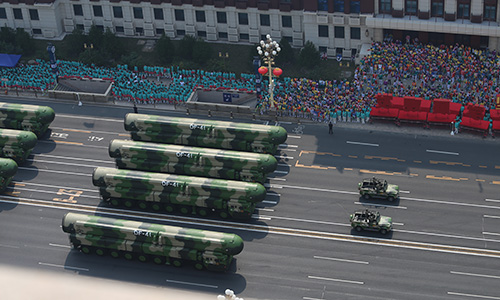 Chinese military experts on Tuesday suggested the use of non-lethal electromagnetic weapons, including low-energy laser devices, in expelling US warships that have been repeatedly intruding into the South China Sea in the past week.
Chinese military experts on Tuesday suggested the use of non-lethal electromagnetic weapons, including low-energy laser devices, in expelling US warships that have been repeatedly intruding into the South China Sea in the past week.
Ships from the Theodore Roosevelt aircraft carrier strike group and America amphibious assault ship expeditionary strike group sailed together in the South China Sea on Sunday for expeditionary strike force drills, the US Pacific Fleet said on its Twitter account on Monday.
This is the third time in just a week US warships are known to have trespassed into the South China Sea: US guided missile destroyer McCampbell on March 10 trespassed into China’s territorial waters in the Xisha Islands, and amphibious assault ship America and littoral combat ship Gabrielle Giffords sailed in operations in the South China Sea on Friday.
To counter US’ repeated trespasses into Chinese territorial waters, the Chinese military has the option of using new approaches, including the deployment of electromagnetic weapons, Song Zhongping, a Chinese military expert and commentator, told the Global Times on Tuesday.
Firing at US warships is not a good choice unless the US fires first, and that would result in the start of a China-US military conflict, Song said, noting that bumping into US ships might also not be a good counter, as lessons have been learned from the Black Sea bumping incident between the Soviet Union and US in 1988.
But the use of electromagnetic weapons, including low-energy laser devices, could be viable, as they can temporarily paralyze US ships’ weapon and control systems without visible conflict but can send a strong warning, according to Song.
Electromagnetic weapons can emit electromagnetic waves that can potentially jam electronic devices of target vessels and will not cause casualties, military observers said.
The US accused a Chinese destroyer of using lasers on February 17 on its patrol aircraft near Guam, even though it was the US aircraft that had initially conducted repeated close-in reconnaissance that interrupted the Chinese fleet’s normal navigation and training. This is a good example and could be applied more, Song said.
The US side is using “freedom of navigation” as an excuse to repeatedly enter the South China Sea to flex its muscles and cause trouble, which are acts of hegemony that violate international law, threatening peace and stability in the region, People’s Liberation Army (PLA) Southern Theater Command spokesperson Li Huamin said after the US naval activities on March 10, noting that the US warship was expelled by Chinese naval and aerial forces.
China has undisputed sovereignty over the islands in the South China Sea and nearby waters, and the Chinese military remains highly vigilant at all times. It will take any necessary measure to safeguard national sovereignty, peace and stability in the South China Sea, Li said after that incident.
The PLA has yet to announce its response to the US activities on Friday and Sunday.
Comment: Chinese are now copying the Russians. A couple of years ago I could find virtually no Chinese government media articles on their nuclear exercises.
Chinese Rocket Force exercise ensures nuclear counterattack capability
By Liu Xuanzun Source:Global Times Published: 2020/1/16 23:18:40
 China reveals its most advanced nuclear-armed intercontinental ballistic missile, the DF-41, at the National Day parade in Beijing on October 1, 2019. Photo: Fan Lingzhi/GT
China reveals its most advanced nuclear-armed intercontinental ballistic missile, the DF-41, at the National Day parade in Beijing on October 1, 2019. Photo: Fan Lingzhi/GT
The Chinese People’s Liberation Army (PLA) Rocket Force has conducted a nuclear attack survival exercise where troops in an underground missile facility had to endure extreme conditions and make sure they could still launch nuclear counterattacks.
During the undated exercise, a Rocket Force brigade mobilized into the launch bunker at an undisclosed location and completely sealed themselves off from the outside world, as the troops readied for combat, China Central Television (CCTV) reported on Wednesday.
The bunker was then struck by a mock hostile nuclear attack as the troops inside, fully dressed in protection suits, carried out contingency plans and operated missiles for upcoming counterattacks, according to the report.
They also simulated a situation where missile fuel leaked after a hostile strike and a troubleshooting team was immediately deployed to repair.
Tactics including a fast missile condition check, rapid logistics, bunker defense and hasty launch were also practiced, CCTV reported.
While China is one of a few countries in the world that operate nuclear weapons, it has promised no first use, a military expert who asked not to be named told the Global Times on Thursday.
It was crucial the force survive an initial hostile strike to launch a counterattack, the expert noted. Such exercises ensure that capability and contribute to China’s nuclear deterrence, the expert said.
China has a series of defense facilities located deep under mountains dubbed the “Underground Steel Great Wall,” which “guarantee the security of the country’s strategic arsenal” against potential attacks, including those from hypersonic weapons, Qian Qihu, a key architect of the fortifications who won China’s highest science and technology award of 2018, told the Global Times in a previous interview.
At the National Day military parade on October 1 last year, China displayed the DF-5B silo-based nuclear-armed intercontinental ballistic missile.
The parade also showcased the DF-31AG and DF-41 road-mobile ICBM, DF-26 nuclear/conventional intermediate-range ballistic missiles (IRBM) and JL-2 submarine-launched ballistic missile (SLBM).
No nuke is expected to be ever used again, but China needs to protect itself by retaining its nuclear deterrent, developing and practicing with the weapons, analysts said.
No comments:
Post a Comment